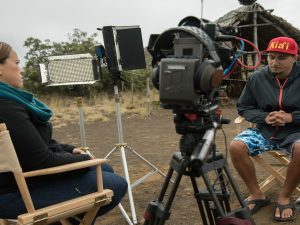“The waʻa is our origin. It is why we are here in these islands.”
“Ua riro ʻo ke kumuhonua ia o ko Faʻafaʻite te mahana mutaʻa iho ra te fo faʻa o te waʻa. Ko kākou kupuna mai ka waʻa i te whenua te mau fo faʻa. He haʻa, faa tura te heʻe tena mau ohipa kēlā mau mea a pau loa i lawe ʻia mai e lākou a puni ka moana nui. ʻO ka waʻa ke kumu o kākou, ka maohi i ʻaneʻi nei.”
“Ua waiho lākou i kekahi tapaʻo ma ka ʻāina e like ma ka marae. He waʻa ʻuhane e pili ai me nā kupuna.”
Ua nui ka pōmaikaʻi o nā holokai i ka pae i kēia waʻa ma ka ʻāina nei me ka hoʻokupu aku i ka leo pule a oli, he mau hana e hoʻopili maʻamau ʻole ʻia ʻana i nā holokai akā, he maʻamau nō no kēia poʻe.
“I ka wā kahiko, ʻaʻole ʻoe aʻo I ka hoʻokele wale nō. ʻAʻole ʻoe aʻo I ka holowaʻa wale nō. Pili no ka pule a me ke oli i nā ʻano hana noʻeau like ʻole. No ka mea, ma o kēia hana, pēlā nō e hoʻohanohano ai, e mahalo ai i nā kūpuna no ka hāʻawi ʻana mai i ka ʻike.”
Ua hoʻokupu aku ʻo Maya i wahi hula noho i ka wahine e kaulana ai ia wahi pana o uka, ʻo ia hoʻi ʻo “Te Ura Wahine,” ke akua wahine i kaulana ma Hawaiʻi ma ka inoa ʻo Pele ʻoiai, ʻo Fare Hape nei kahi āna i noho ai ma mua o kona holo ʻana aku i Hawaiʻi.
“He mea nui a he mea waiwai ka hoʻi ʻana mai i ʻaneʻī a me ka ʻike maka ʻana i kona wahi i noho ai ma mua. Ua ʻike maka ʻia nō kona kino lau o ka wailele, ka ua. He mea nui ka ʻike maka ʻana.”
“A ua koho ʻia kēia mele ʻo kekahi manaʻo o Mālama Honua. Ua hōʻike mai ʻo kekuhi iā mākou kekahi honua, ʻo ia hoʻi kēia ke kino o ke kanaka. Ma kekahi ʻano, he kūpono paha kēlā mele i ka manaʻo nui o kēia holo ʻana a puni ka honua, ʻo ia hoʻi ʻo Mālama Honua.”
He mau haʻawina lua ʻole kēia e aʻo a kaʻanalike ʻia ʻana aku ma ka pōʻaiapili waʻa, ko uka a ko kai kekahi.
[/spb_text_block] [/spb_tab]
[spb_tab title=”English”] [spb_text_block pb_margin_bottom=”no” pb_border_bottom=”no” width=”1/1″ el_position=”first last”]
[dropcap2]T[/dropcap2]he crew took a break from the hustle and bustle of the city of Papeete and headed for the hills to Fare Hape, the home of Tahiti’s double-hulled canoe, Faʻafaite.
“This place is Faʻafaite’s origin. The waʻa are extremely important to us because they brought our ancestors to this land. And the values that sustain us until today: humility, respect, aloha for this place and each other, these are values from the waʻa that our kupuna brought with them here and throughout the Pacific. The waʻa is our origin. It is why we are here in these islands.”
“Our kupuna left us cultural treasures for us here on land like these marae. These marae are waʻa as well, waʻa on land but waʻa nonetheless. They are spiritual waʻa that connect us, and carry us, to our kupuna,” said Matahi Tutavae, president of the Tahitian voyaging canoe Faʻafaite.
The crew was fortunate to embark on this vessel, bringing gifts or prayer and chanting. These may seem like unusual tasks for sailors but are common practice for this crew.
“Our kupuna weren’t just navigators or just sailors. Prayer and chanting were a part of most activities. As we continue that way of being, we honor and mahalo our kupuna and the knowledge they left us,” said Maya Saffery, a cultural protocol specialist for the Worldwide Voyage.
Maya offered a hula for “Te Ura Wahine”, the Tahitian name of the Hawaiian deity Pele who lived at Fare Hape before migrating to Hawaiʻi.
“It was important to come here and witness this place were she resided. We saw her various forms in the waterfalls and rain. It was important for us to experience this.”
I chose “A ka Luna o Puʻuonioni” as my offering here at this home of Pele because it reminds us of the value that. One meaning of Mālama Honua, or caring for place, can be about this “place” right here, the individual, out body and spirit. It seemed appropriate given the Worldwide Voyage theme of Mālama Honua, or caring for earth,” said Maya.
These are priceless lessons being shared via the waʻa, both off and on the ocean.
“Today, these important lessons from the waʻa are fading. If we don’t want these things to disappear from us, we have to think long and hard about this. In the waʻa setting, if people lose this knowledge, they will fade themselves and perish. The same applies on land. These values must carry on with our children or they will be lost. We have to think about what lies ahead of us. It is a lesson we teach and learn on the waʻa. We don’t just sail aimlessly from island to island. We sail with purpose, knowing where we are headed. Again, we can apply this lesson on land. We are constantly reminded about the beauty and wonder of Faʻafaite. It is an amazing classroom to teach and perpetuate these ways,” said Matahi.
[/spb_text_block] [/spb_tab] [/spb_tabs]



